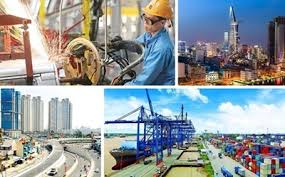Economic and industrial growth serves VN's development
VGP – As shown in statistics from the United Nations Conference on Trade and Development (UNCTAD), Viet Nam attracted up to US$16 billion of foreign direct investment (FDI) last year.
 |
|
Illustration photo |
Meanwhile, the Ministry of Planning and Investment (MPI) announced that in the first nine months of 2019, foreign investors poured more than US$ 18.4 billion into projects in Viet Nam.
These positive achievements were attributed to the significant efforts made by the Vietnamese Government in developing infrastructure at key economic and industrial zones and enhancing their FDI attraction capabilities.
For example, the planning and construction of the port city of Hai Phong into a new economic center in the northeastern region has drawn a large amount of foreign investment into the field of high-tech agriculture.
The economic and industrial growth will enable Viet Nam to be an important partner and market in Southeast Asia in the next decade.
In addition, Samsung’s latest move in Viet Nam has contributed to boosting the country’s eight-month manufacturing activities, in which production of mobile phones increased by 11 per cent, and that of smartphones rose 15.8% on-year. Samsung takes the lead in production and export of these products in Viet Nam.
In addition, a World Bank (WB) report on East Asia Pacific Economic Update, published in October 2019, gave a positive assessment about the Vietnamese economy in the medium term despite risks which are on a declining trend.
WB lead economist in Viet Nam Jacques Morisset said that Viet Nam still remains an attractive destination for foreign investors and attracts more FDI than other countries in the region.
According to the General Statistics Office (GSO), a rise in production and exports of electronics items have contributed greatly to a climb in the country’s eight-month manufacturing industry, which accounts for 80% of industrial growth and will will help drive the economy’s growth.
Spain-based FocusEconomics has released its latest forecast for Viet Nam’s economic outlook, stating that the economy will expand 6.7% in 2019, making itself one of the region’s star performers this year.
The firm stated that Viet Nam’s economic growth continuing will largely depend on industrial growth driven by a climbing manufacturing sector.
In an article analyzing the regional economic situation, published recently on Lianhe Zaobao, a Chinese-language daily in Singapore, Sam Cheong Chwee, Executive Director at United Overseas Bank (UOB) and Head of UOB Group’s Foreign Direct Investment Advisory Unit, stated that “Viet Nam has been emerging as a bright star in terms of foreign investment attraction in Southeast Asia”.
WB experts said the strong growth of domestic consumption and increasing competitiveness are the two main drivers of Viet Nam's economic growth at the moment.
Also seeing Viet Nam with a bright outlook, global data provider TradingEconomics last week stated that industrial production in Viet Nam is expected to rise 8.3% by the end of this quarter, and 8% in 12 months’ time.
In the long term, the Vietnamese industrial production is projected to trend around 6.9% in 2020 due to uncertainties in the global market which will affect Viet Nam’s economy.
By Vien Nhu

